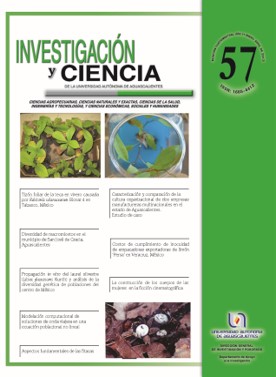Characterization and comparison of organizational culture in two multinational manufacturing companies in the state of Aguascalientes. Case study
DOI:
https://doi.org/10.33064/iycuaa2013574017Keywords:
organizational culture, multinational manufacturing companiesAbstract
The research characterizes the organizational culture in two multinational manufacturing companies in the state of Aguascalientes; besides comparing and determining whether there are significant similarities between the two cultures. Organizational culture is essential for any business and it functions for understanding the meaning that employees give to their organizational reality. A case study method was used in two companies; a survey was applied to a sample of 270 and 171 people in each company. Results: Hypothesis is verified, the type of dominant culture is that of market; but there are significant differences in the types of cultures of the companies analyzed. Conclusion: the dominant organizational culture type market, matches the organizational culture that occurs in multinational manufacturing companies.
Downloads
References
• ALMODÓVAR, P., Because Location Matters: What Multinationals Must Know About Cultural Distance. Journal of Globalization, Competitiveness and Governability, 3(3): 34-63, 2009. DOI: https://doi.org/10.3232/GCG.2009.V3.N3.02
• BEYENE, T., Diagnosing Ercoe’s Organizational Culture and Indicating Members’ Preferred Culture. PM World Today, XIV, Issue II. 1- 9, February, 2012.
• BRAUNSCHEIDEL, M.; SURESH, N.; BOISNIER, A., Investigating the impact of organizational culture on supply chain integration. Human Resource Management, 49(5): 883-911, september-october, 2010. DOI: https://doi.org/10.1002/hrm.20381
• CAMERON, K.; QUINN, R., Diagnosing and changing organizational culture. USA: Ed. Jossey Bass, 242 pp., 2006.
• GARCÍA, D.; MARTÍNEZ, M.; MALDONADO, G.; MADRID, A.; GONZÁLEZ, M.; VIVANCO, S.; AGUILERA, L., Innovación y cultura empresarial de las MIPYME. México: Universidad Autónoma de Aguascalientes, 187 pp., 2009.
• HOFSTEDE, G.; HOFSTEDE, G.; MINKOV, M., Culture and organizations: Software of the mind. USA: Mc Graw Hill, 561 pp., 2010.
• KAMALUDDIN, A.; RAHMAN, R., Proceedings of the International Conference on Intellectual Capital. Knowledge Management & Organizational Learning, 584-595, 2010.
• LERTXUNDI, A.; LANDETA, J., The effect of cultural context on the efficiency of best practices in human resource management. Cuadernos de Gestión, 11(2), 127-148, octubre, 2010. DOI: https://doi.org/10.5295/cdg.100213al
• PETTIGREW, A., On Studying Organizational Cultures. Administrative Science Quarterly, 24: 570-581, december, 1979. DOI: https://doi.org/10.2307/2392363
• QUINN, R.; ROHRBAUGH, J., A spatial model of effectiveness criteria: Towards a competing values approach to organizational analysis. Management Science, 29: 363-377, 1983. DOI: https://doi.org/10.1287/mnsc.29.3.363
• SCHEFFKNECHT, S., Multinational Enterprises. Organizational Culture vs. National Culture. International Journal of Management Cases, 73-78, DOI: https://doi.org/10.5848/APBJ.2011.00113
• SCHEIN, E., Organizational Culture and Leadership. USA: Ed. Jossey Bass, 436 pp., 2010.
• VIEGAS, M., Différences culturelles et performance des firmes multinationales. Revue française de gestión, 216: 33-44, 2011.
Downloads
Published
How to Cite
License
Copyright (c) 2013 Carlos Roberto Rodríguez Castellanos, Laura Romo Rojas

This work is licensed under a Creative Commons Attribution-NonCommercial-ShareAlike 4.0 International License.
Las obras publicadas en versión electrónica de la revista están bajo la licencia Creative Commons Atribución-NoComercial-CompartirIgual 4.0 Internacional (CC BY-NC-SA 4.0)









